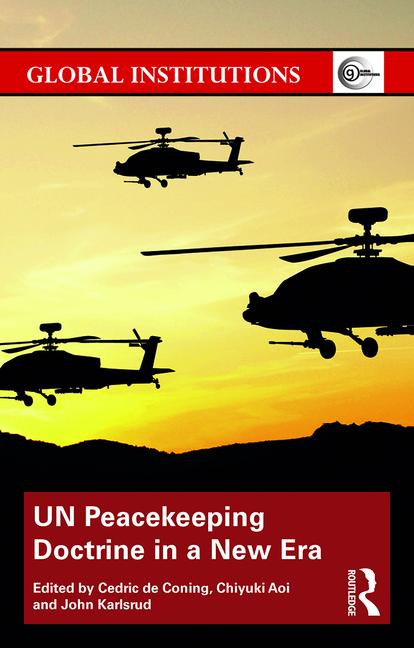国連平和維持活動は、一般に、同意、不偏性、(自衛と任務の防衛以外の) 武力の不行使の原則に基づく活動として知られている。しかし、一昔前の平和維持がそうであったように、停戦や和平合意の存在、活動への同意などを、必ずしも前提条件として想定することができない時代となった。和平合意が形骸化したり、紛争の政治的解決がないまま、平和維持活動が展開されるような場合である。
つまり、平和維持活動とはいえ、これが一定の政治目的 (紛争の終結、安定化あるいは平和への移行) のための、軍事・文民部門双方の高い能力を要請する活動となってきているということだ。現実に、活動の受け入れ国や地域の状況が不安定になれば、要員を派遣する側 (国連とその加盟国) はそれなりの対応を求められる。
本書は、紹介者が、ノルウエー国際問題研究所の共同研究者と共に、国際的な研究グループを率い、平和維持活動の理論と現実とのギャップについて再考する試みである。現存する国連の平和維持活動のうち、マリやコンゴ民主共和国などでは、活動が危険にさらされ、紛争の政治解決が得られていない中での安定化や、市民の保護といった任務の実施に苦戦している。本書は、こういった例がより頻繁になっていることを踏まえ、その平和維持活動ドクトリン上の影響を考察した、先端領域の研究書である。
ドクトリンとは、活動に際して、状況に応じて柔軟に適用される一定の原則を指す (決して、機械的に当てはめられるものではないことに留意する必要がある)。本書の問題意識は、紛争の現実が変遷しているならば、既存の国連平和維持活動の原則は、果たして適切な指針としての役割を果たしているだろうか、というものである。当然、不適切な原則が適用されれば、活動のコストは上がり、失敗の可能性は高くなる。適切なドクトリンのみで成功は導かれるものではないが、明確な原則は、活動の評価と教訓を可能とさせるものである。
本書では、今日の国連平和維持活動を新たに類型化し、特に以下の類型を中心に、原則と現場の活動との間のギャップを実証的に検証する。
●新しい国家と行政の支援 (南スーダン、コソボ、東テイモール)
●和平合意のない中での市民の保護 (ダルフール、チャド・中央アフリカ共和国、ハイチ、コートジボワール)
●反乱からの政府の防衛 (コンゴ民主共和国、マリ)
本書は、こういった困難な事例に対処するため、平和維持活動とは根本的に異なる安定化ドクトリンを整備する必要性を訴え、改革の方向性を提示している。
本書はまた、ドクトリンの歴史的変遷を概観し、主要加盟国 (米、英、中国、ロシア、主要要員派遣国) のドクトリンへの取り組みも分析している。
(紹介文執筆者: 公共政策大学院 教授 青井 千由紀 / 2019)
本の目次
[Chiyuki Aoi, Cedric de Coning and John Karlsrud]
Part I: Doctrinal Debates
1. U.S. Doctrine and the Challenge of Peace Operations
[William Flavin]
2. The United Kingdom and UN Peacekeeping
[David Curran and Paul D. Williams]
3. France and the Evolution of UN Peacekeeping Doctrine
[Alexandra Novosseloff and Thierry Tardy]
4. China’s Evolving Doctrine on UN Peacekeeping
[He Yin]
5. The Russian Perspective on UN Peacekeeping: Today and Tomorrow
[Maxim Bratersky and Alexander Lukin]
6. The Large Contributors and UN Peacekeeping Doctrine
[Seun Abiola, Cedric de Coning, Eduarda Hamann and Chander Prakash]
Part II: UN Peacekeeping Practice
7. Supporting the Formation of New States and Administrations: South Sudan, Kosovo and Timor Leste
[Mateja Peter and Diana Felix da Costa]
8. Protection of Civilians in Absence of Peace Agreements: Darfur, Chad/CAR, Haiti & Cote d’Ivoire
[John Karlsrud and Ingvild M. Gjelsvik]
9. Protecting Governments from Insurgencies: The Democratic Republic of the Congo and Mali
[Stian Kjeksrud and Lotte Vermeij]
Part III: Emerging Issues
10. Exploiting the Sea: Naval Involvement in UN Peacekeeping: Prospects and Difficulties
[Ian Bowers]
11. New Technologies and UN Peacekeeping Operations
[John Karlsrud]
Conclusion: Towards a United Nations Stabilization Doctrine: Stabilization as an Emerging UN Practice
[Chiyuki Aoi and Cedric de Coning]
関連情報
'Peacekeeping is a creation of practice rather than law, and it has gone through many transformations since its creation. As conflicts go through a profound mutation, so should peacekeeping. This volume offers important recommendations that should help peacekeeping reinvent itself, going beyond principles that are no more adapted to the realities of contemporary conflict.' - Jean-Marie Guehenno, the former UN Under Secretary-General for Peacekeeping and currently the President & CEO of the International Crisis Group (ICG)
'Aoi, Karlsrud and De Coning have produced a timely and relevant study on the changing nature of UN Peacekeeping, focusing on the widening gap between principles and practice, and the need to upgrade doctrine to include key concepts such as stabilization. The authors not only focus on the current challenges posed by the latest generation of lethal non-state actors, but they also offer direction for how UN Peacekeeping doctrine and political realties can be reconciled.' – Dr. Karin von Hippel, Director General, Royal United Service Institute
'Realistic. Timely. objective. Extremely necessary. Touch the key point: principles, doctrine and practice; the most important question in UN peacekeeping. All the peacekeepers, from New York to the field should read this book, fundamental to protect civilians and UN itself.' - Lt.Gen. Carlos Alberto Santos Cruz, former Force Commander of the UN mission in the Congo (MONUSCO)
'At a time when peace operations are confronting increasingly complex and dangerous challenges, the United Nations' High Level Panel could only begin a much-needed attempt to bring doctrine and practice closer together. This thoughtful volume significantly advances this essential task: both practitioners and analysts should read it and be provoked to engage in a debate which is vital for the UN and its partners.' - Ian Martin, Executive Director, Security Council Report and member of the UN High Level Panel on Peace Operations
'The security architecture of the 21st century places an increasing reliance on the use of force in peacekeeping. The Security Council has crafted mandates, which in some cases go beyond the existing norms of peacekeeping and this has resulted in situations where existing physical and doctrinal deficiencies leaves peacekeepers vulnerable and unsuitable for the task. This book works towards identifying the gaps between international ambitions, present doctrine, principles, operational procedures and actual practice, reappraises the doctrinal deficit and presents options for a UN doctrine for future missions. Undoubtedly a valuable literary addition to the UN Peacekeeping reform process that is presently underway.' - Lt.Gen. Abhijit Guha, former Deputy Military Advisor to the UN and member of the UN High-level Independent Panel on Peace Operations



 書籍検索
書籍検索


